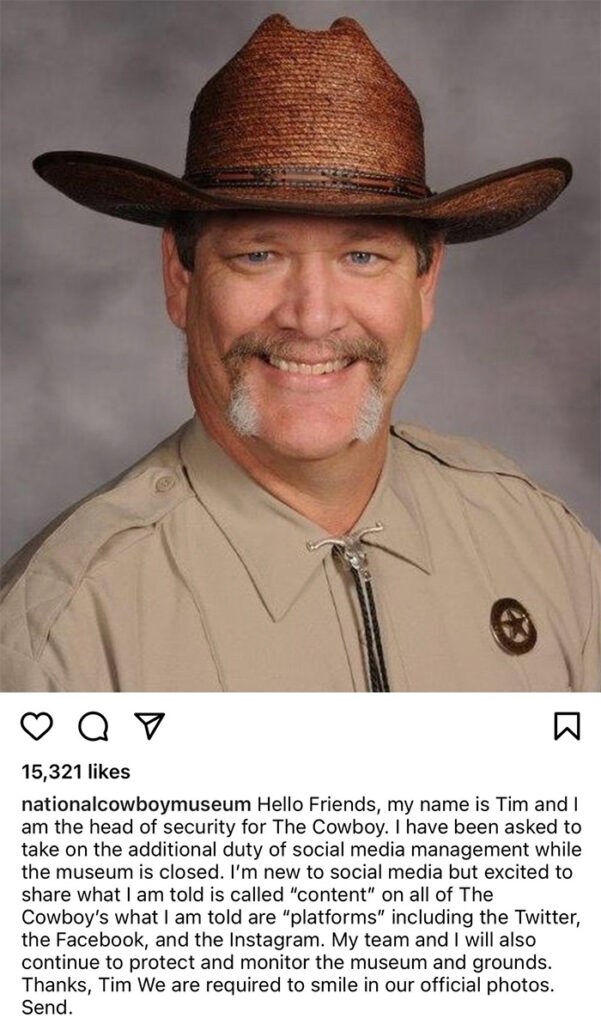On March 17, 2020, before Oklahoma City’s National Cowboy & Western Heritage Museum was forced to close, the museum’s Director of Security and Operations, one stetson-donning Tim Tiller, was tasked with an additional gig — manning the institution’s social media accounts during the shutdown. Tiller, whose relationship with social media was tenuous at best, took to his new position with a stern aplomb, posting to Instagram:
 “Hello Friends, my name is Tim and I am the head of security for The Cowboy. I have been asked to take on the additional duty of social media management while the museum is closed. I’m new to social media but excited to share what I am told is called ‘content’ on all of The Cowboy’s what I am told are ‘platforms’ including the Twitter, the Facebook, and the Instagram. My team and I will also continue to protect and monitor the museum and grounds. Thanks, Tim. We are required to smile in our official photos. Send.”
“Hello Friends, my name is Tim and I am the head of security for The Cowboy. I have been asked to take on the additional duty of social media management while the museum is closed. I’m new to social media but excited to share what I am told is called ‘content’ on all of The Cowboy’s what I am told are ‘platforms’ including the Twitter, the Facebook, and the Instagram. My team and I will also continue to protect and monitor the museum and grounds. Thanks, Tim. We are required to smile in our official photos. Send.”
The administrative stop-gap led to an online storm: charmed by Tim’s no-nonsense relationship to the Cowboy, a quarantined following grew to over 400k across platforms, and even inspired an exhibition, #HashtagTheCowboy, based on Tim’s first-person explorations of the Cowboy’s collection. Tim’s online escapades have breathed new life into the museum’s old-school ethos; founded in 1955, the Cowboy boasts a premier collection of Western art and artifacts, aimed at helping visitors gain a better understanding of the region.
This unlikely digital reinvigoration in the hands of a novice forms the focus of Seth Spillman’s plenary session on April 16 at the upcoming MW21 conference. The Cowboy’s Chief Marketing Officer will outline the ways in which a fun, quirky idea can turn into a maelstrom, and what concepts marketers can take away from the institution’s example. It’s just one segment in an event with its finger on the pulse of digital cultural heritage.
Hosted by MuseWeb, the leading purveyor of cultural heritage conferences in North America and Asia since 1997, MW21 will unfurl its schedule across the month of April, one that’s custom-designed to improve audience absorption, and consisting of shorter, more impactful sessions spread out over the course of several weeks rather than days. MW21’s docket boasts a diverse range of speakers and subjects, including sessions on inclusive design, digital transformations, and an opening keynote conversation between Lonnie Bunch, Secretary of the Smithsonian Institute, and Ariana Davis, the Digital Director of OprahMag.com.
As we enter what will hopefully prove to be the final stages of the COVID lockdown era, such conversations about the future of digital applications in institutional settings have only grown increasingly urgent. There’s no avoiding the economic toll the pandemic has had on the arts sector; the financial loss is staggering, and an increase in virtual options to fill the in-person gaps has created a very different landscape for museum visitors and professionals alike. To that end, it seems fitting that MuseWeb’s 25th annual conference is one concerned with change, adapting, and preparing for the needs of cultural institutions in years to come.




